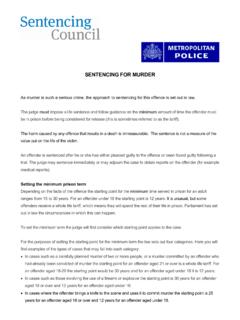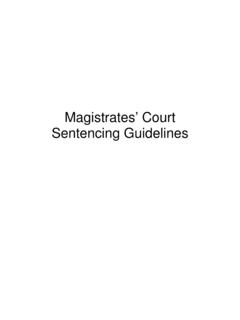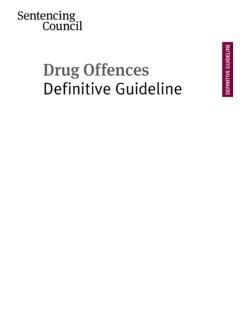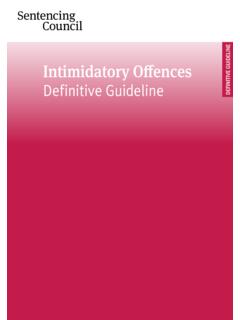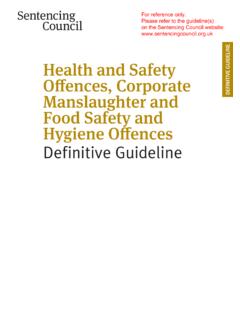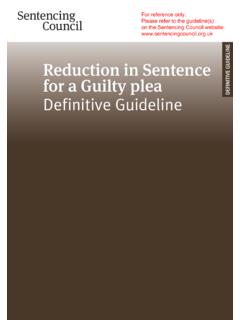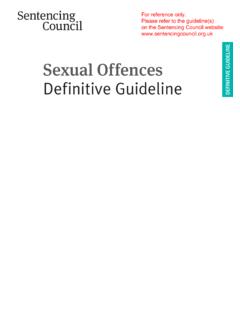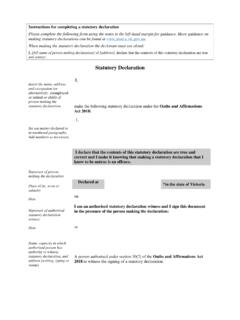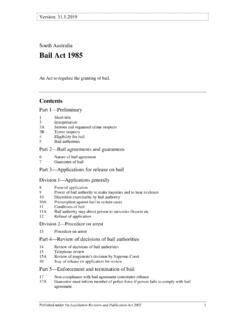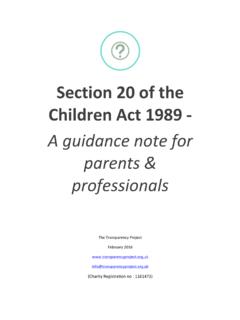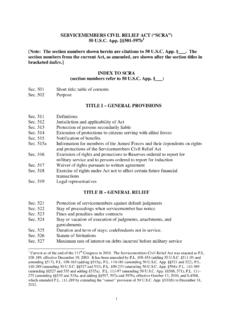Transcription of Fail to Surrender to Bail - sentencingcouncil.org.uk
1 SGC. Sentencing Guidelines Council Fail to Surrender to bail Definitive Guideline FOREWORD. In accordance with section 170(9) of the Criminal Justice Act (CJA) 2003, the Sentencing Guidelines Council issues this guideline as a definitive guideline. By virtue of section 172 of the CJA 2003, every court must have regard to a relevant guideline. This guideline applies to the sentencing of offenders convicted of failing to Surrender to bail who are sentenced on or after 10 December 2007. bail Act offences are committed in significant numbers each year and are a major cause of disruption, delay and unnecessary cost for the criminal justice system. A. prime objective of courts is to bring criminal proceedings to a conclusion as soon as practicable, and a rigorous and consistent response when offenders fail to answer bail is needed to help achieve this.
2 This, in turn, may help to discourage future offending. Where it is not possible to dispose of the original offence, sentencing for a bail Act offence should normally be undertaken separately and carried out as soon as appropriate in light of the circumstances of an individual case. When a bail Act offence has been committed, the sentence must be commensurate with the seriousness of the offence and must take into account both the reason why the offender failed to Surrender and the degree of harm intended or caused. For these purposes, harm' is not only that caused to individual victims and witnesses but includes the consequential effect on police and court resources and the wider negative impact on public confidence in the criminal justice system.
3 As the considerations for offences committed by youths will differ markedly from those relevant for adult offenders, this guideline relates to the sentencing of adult offenders only. The Council has appreciated the work of the Sentencing Advisory Panel in preparing the advice on which this guideline is based and is grateful to those who responded to the consultation of both the Panel and Council. The advice and this guideline are available on or from the Sentencing Guidelines Secretariat at 4th Floor, 8-10 Great George Street, London SW1P 3AE. A summary of the responses to the Council's consultation also appears on the website. Chairman of the Council November 2007. i Sentencing Guidelines Council CONTENTS. Foreword i A.
4 Statutory provision 3. B. Assessing seriousness 3-7. (i) Culpability 4. (ii) Harm 4-5. (iii) Nature and seriousness of original offence 5. (iv) Aggravating and mitigating factors 6-7. C. Procedural issues 7-9. (i) When to sentence 7-8. (ii) Consecutive and concurrent custodial sentences 8. (iii) Conducting trials in the absence of the defendant 8-9. D. Sentencing ranges and starting points 10-11. The decision making process 11. E. Factors to take into consideration and Guideline 12-13. 1. Sentencing Guidelines Council FAIL TO Surrender TO bail . A. Statutory provision 1. Section 6 of the bail Act 1976 states: 1) If a person who has been released on bail in criminal proceedings fails without reasonable cause to Surrender to custody he shall be guilty of an offence; and 2) If a person who: (a) has been released on bail in criminal proceedings, and (b) having reasonable cause therefor, has failed to Surrender to custody, fails to Surrender to custody at the appointed place as soon after the appointed time as is reasonably practicable, he shall be guilty of an offence.
5 2. An offence under subsection (1) or (2) is punishable either on summary conviction or, in the Crown Court, as if it were a criminal contempt of court. The maximum sentence in a magistrates' court is 3 months If the matter is committed to the Crown Court for sentence, or dealt with there, the maximum sentence is 12 months custody and the sentence is subject to the usual appellate B. Assessing Seriousness 3. When assessing the seriousness of an offence, the court must consider the offender's culpability and any harm which the offence caused, was intended to cause or might foreseeably have 4. In assessing culpability, a court will need to consider whether the failure to Surrender was intended to cause harm and, if so, what level of harm.
6 In assessing harm, a court will need to consider to what extent the failure to Surrender impeded the course of justice. When applied to bail Act offences, harm includes not only the harm caused to individual victims and witnesses but the consequential drain on police and court resources and the wider negative impact on public confidence in the criminal justice system. 5. The same approach to sentencing should be adopted whether the offence is committed contrary to section 6(1) or to section 6(2). However, the offence contrary to section 6(2) requires that there had been a reasonable excuse not to attend on the original date and so the degree of harm arising from the failure to attend as soon as reasonably practicable after that date is likely to be less.
7 Accordingly, the seriousness of the offence is likely to be less also. 1 Police and Justice Act 2006, amends various sections of the Criminal Justice Act 2003 so that this maximum sentence is not affected by the general provisions relating to custodial sentences of less than 12. months when in force 2 Administration of Justice Act 1960, 3 Criminal Justice Act 2003, (1). 3. Sentencing Guidelines Council (i) Culpability 6. The obligation on a person who is granted bail is to Surrender to custody at the court or the police station as required. The assessment of culpability requires consideration of the immediate reason why the defendant failed to appear. This can range from forgetfulness (comparable to the category of culpability described as negligence in the Council guideline on seriousness4) or fear of the outcome of the hearing through to a deliberate act.
8 Where the failure to Surrender was deliberate, it will be relevant whether it was designed to disrupt the system to the defendant's advantage or whether the defendant simply gave no thought at all to the consequences. (ii) Harm 7. Some degree of harm, even if only a minor delay or inconvenience to the authorities, will always be caused when a defendant fails to Surrender . The degree of harm actually caused will vary considerably depending on the particular circumstances of the offence. The harm that the offence might foreseeably have caused5 must also be taken into account. 8. Failure to Surrender to a court for any reason (whether bail is granted by the police or by a court) inevitably delays justice. Potentially, it will result in additional distress to victims and witnesses.
9 It will almost always waste public money in the form of court time and the resources of the prosecution, the police and the defence. (a) Where a defendant fails to appear for a first court hearing but attends shortly afterwards, the only harm caused is likely to be the financial cost to the system. Procedural delays may also be caused by the prosecution, the defence or the Courts Service at various stages of the process and, where a case could not have proceeded even if the defendant had surrendered to bail , this should be taken into account when assessing the harm actually caused. (b) Where a defendant appears for trial on the wrong day but enters a late guilty plea enabling the case to be disposed of to some degree at least (albeit with some delay and disruption), the harm caused by the delay may be offset by the benefits stemming from the change of plea.
10 (c) The most serious harm is likely to result when a defendant fails to appear for trial, especially if this results in witnesses being sent away. A lengthy aborted trial in the Crown Court will be more harmful than a short hearing in a magistrates' court though each situation has the potential to affect public confidence in the system. (d) Where a court decides not to proceed to trial in the absence of the defendant (see paragraphs 34-39), interference with the course of justice may be particularly acute. Memories may become less certain with the passage of time. Victims and witnesses, many of whom find the prospect of preparing for and attending court daunting, are likely to be caused distress and/or inconvenience.
